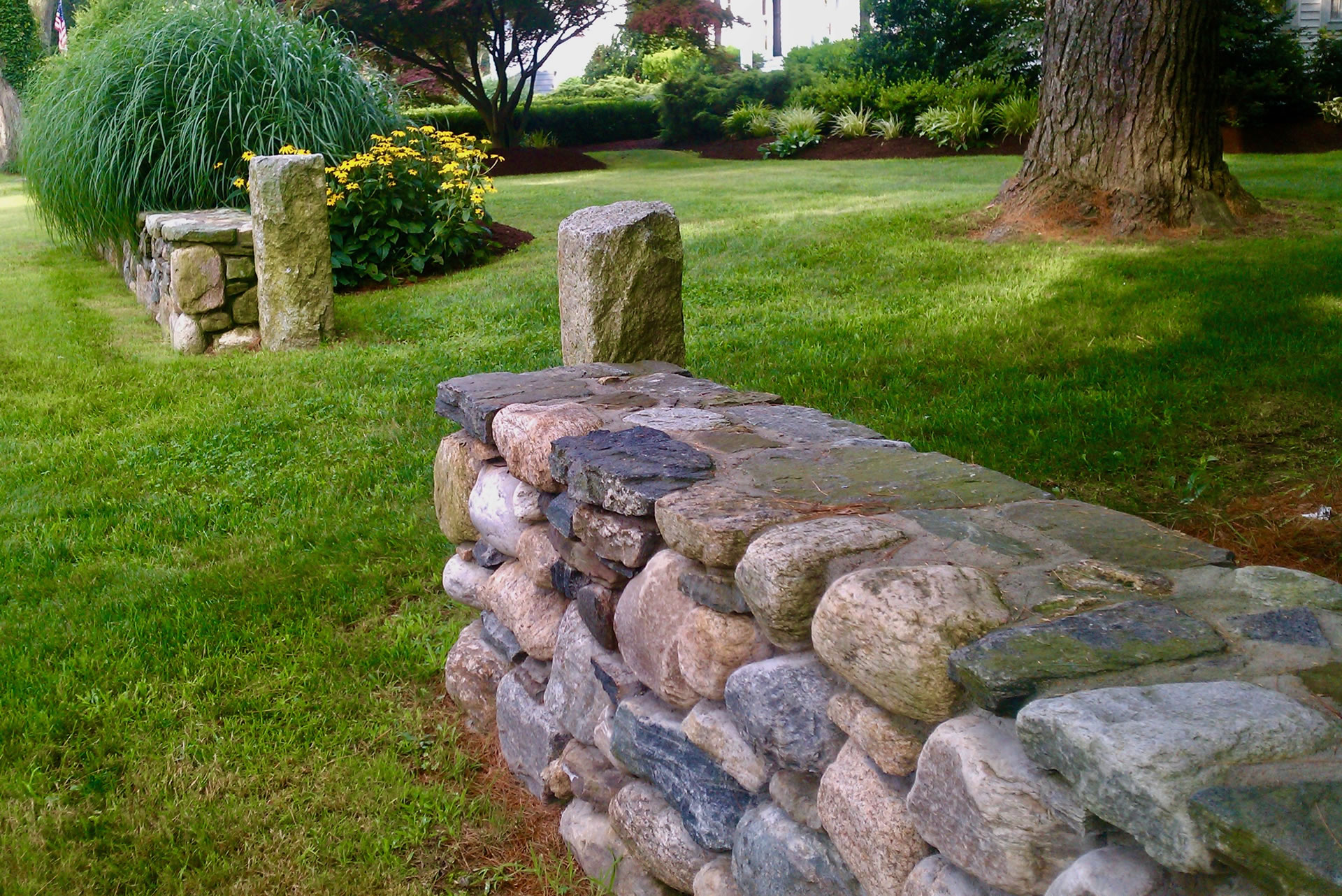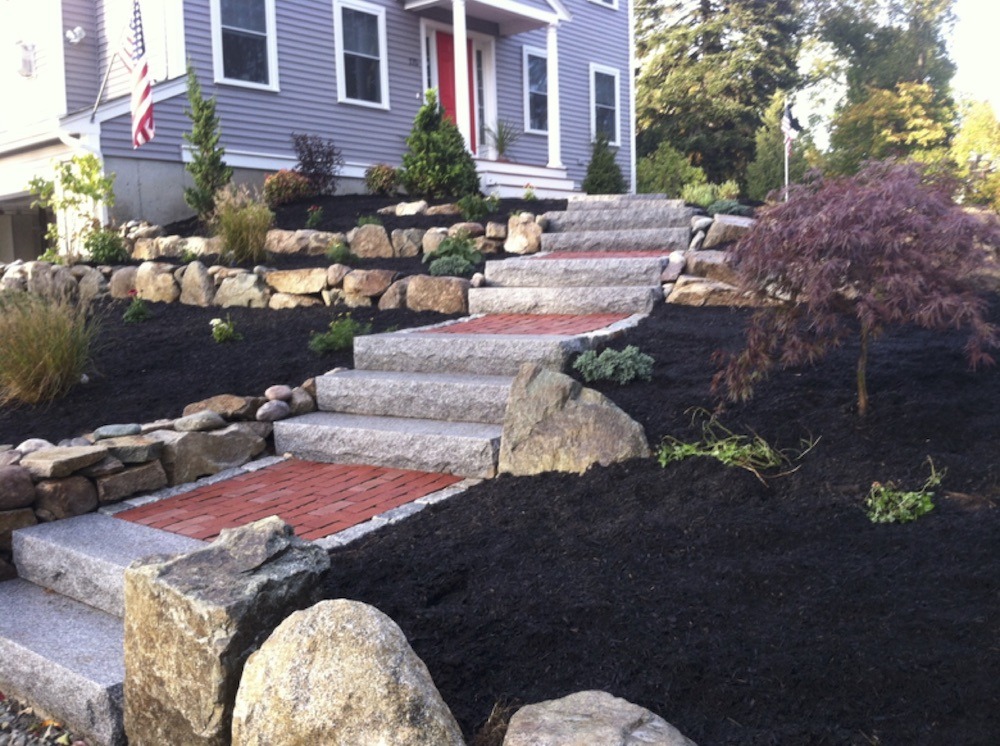The combining of masonry and landscaping creates a new hybrid – Hardscaping.
Growing up as a second-generation stone cutter and mason, learning the trade from my father, I was always interested in landscaping. Little did I know, over the next three decades that combining the two would bring me into the new world of their hybrid – hardscaping. As the years continued with designing and installing exterior projects for residential and commercial properties the development of hardscaping started to take shape. Today it has become one of the most flexible and creative ways to combine endless options resulting in custom designs.

Growing up through the 70s and 80s working as a tender for my father, he called us “lumpies,” my world was full blown masonry. Mixing cements, mortars, concrete and cutting full veneer stone with carbide chisels and hammers was our normal day. But when we started to install dry set patios and walkways, we were branching into hardscaping. One of the features we would add to certain projects was an old granite post, one that we would split from a larger piece of granite with feathers and wedges.
I would take a carbide drill bit and drill a 1-inch deep hole every 4 inches apart into the old granite, then put in the steel feathers and a steel wedge between the feathers. I would tap the wedges down each one at a time with a small stone hammer. It sounded like an out of tune xylophone. Making sure I hit each wedge with equal force trying to split the granite evenly the stone makes the sound of a whisper and then splits. The beauty of this technique creates a split face on the old granite with the small drill marks from the feathers and wedges adding to the antiquated appearance of the stone.
We would create two posts out of a cut like this and then set them at the end of a wall or in the landscape design as a marker or an old hitching post. This small feature had such an impressive impact on the visuals of the project that I found myself putting them into designs in unique ways.

Whenever we needed to build a retaining wall to hold back a grade my first inclination was to build a stone wall, usually a mix of bulk and palletized fieldstones recreating that old New England wall look. Growing up in the northeast it was and still is a popular look. One customer was looking for something different, something less masonry based and the product they chose was boulders. Larger boulders of all shapes and sizes. I brought in an excavator and operator to set the boulders.
I always used boulders as an accent, like the granite post, but now I had to figure out how to put several together to create this natural looking wall with no cement. I became a huge fan of boulders from this point on. Especially massive boulders that look like they have always been there. One of the tips in setting boulders, is to set them into the soil not just sitting on top of the soil. The goal in hardscaping is to recreate what we see in nature. Boulders tend to be imbedded into the ground with vegetation, moss or lichen growing where the boulder creates shade and traps moisture.
The incredible thing about boulders is that each one can have a different color, grain, and texture creating a unique look with variety. This project was a sunken-in patio on a hill. Boulders create the retaining system in any shape you decide and if you need steps in boulders to have access from the upper to lower areas there are many options. With boulders steps that are more rustic, like solid stone platform steps with a natural edge front, or used granites that were part of curbing, or old walls are excellent choices instead of the clean linear look of a stone or brick tread. Once the boulders are in place there are always spaces between them where you can be creative in the mix of hardscape and landscape.
The pockets are an excellent place to incorporate other decorative stones ranging in sizes from 1” round to basketball bulk stones. These smaller stones can help create holding areas for loam and creative places for succulents or smaller plants like herbs to live. These plants can create aroma and soften the rustic look of the boulders making the marriage of hardscape and landscape a replica of a walk through the woods. That is what we did on this specific job. It opened my eyes to a new way of working.
With patios and walkways, I was used to setting Multiple Bluestone at 1 ½” thick, getting on my hands and knees swinging a rubber mallet to set the Bluestone in a dry base. I wanted to start working a new way of no cements, mortars or concrete. The options were and still are endless – brick, concrete pavers, flagging, porcelain and multiple natural stones. The best way to install the patios or walkways was to find a brick or concrete paver that could be compacted on by a gas compactor.
This installation was faster than the old way of rubber mallets. Of course, stone flagging or multiple stone was still an option setting with the rubber mallet but to compact on a product meant more square footage and less manual hours installing. On top of that the color, texture and size options were endless with the paving brick and concrete pavers. My new point of view was set – think out of the box.
Over the years I would meet landscapers who were turned off with the design and installation of patios, walkways and walls. I would also hear from masons who wanted nothing to do with any landscaping. To me there was so much money left on the table for these two camps. They needed to take a chance on working outside of their areas with some consulting… and that’s what happened. I didn’t know that I was helping to create the hybrid of hardscape in my area south of Boston. The full-bed stone projects with a cement bed became fewer projects in the pipeline as the projects with dry applications and plants became a new way of working.
Of course, the idea of understanding plants, soils and hydration were still not in my wheel house, so I would bring in a landscaper for that part of the project. I would work with them and ask questions about what to do and what not to do with specific plants. I have tremendous respect for these landscapers because they knew exactly what to plant around the hardscape projects I would create. Having them come in was a great way to get educated and create a strong base for subbing out part of designs. The landscape designs always made the hardscape designs stand out.
I mentioned concrete pavers earlier in paving options and there were some standard ones that I always worked with, but over the years these concrete pavers exploded with products, sizes, colors and textures. Not only the pavers but now the wall systems. Some of the wall systems were too linear for me so I would tend to go for the tumbled wall products. They had a worn feel to them and a softer look. Also, I liked the more neutral colors to compliment any other hardscape products.
Every year there was a new product with colors and textures that surprised me, but my inclination was to always have a natural product in the design as well. Combining the two worlds – concrete products with natural products became a staple for me. I would either have a boulder or stone wall with a concrete patio and walkway or a concrete wall with a brick or natural stone flagging patio and walkway. Either way the combinations were endless, giving the client plenty to choose from.
A very popular design over the years has been a circular patio with a firepit in the middle. This kind of patio needs to be a minimum of 12 feet x 12 feet for a standard 3 ½ foot wide firepit and a 4-foot-wide sitting area around the firepit. Now building a perfectly circular patio with natural products is no easy task but with concrete products there were circle kits. They are manufactured with the perfect sizes and a map to create circular patios of every size. To expand them I would add natural cobblestone on the outer perimeter. Cobblestone comes in all shapes, sizes, color, and together with the concrete circle pack they were a great fit. Circular patios were now an easier installation with better profits and design choices.
Hardscaping had now come full circle, no pun intended, for my designs and me. The clients’ taste will always determine what is going to be used for products and today with the options of concrete, natural stone, brick, plants, outdoor lighting, decorative round stones and furniture; hardscaping has expanded into one of the most popular options in the world of design.
Words & Photos: Derek Stearns
